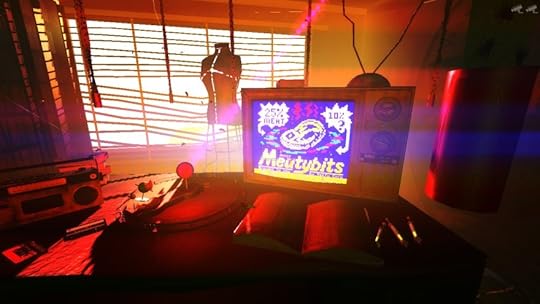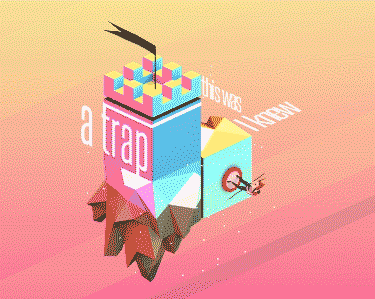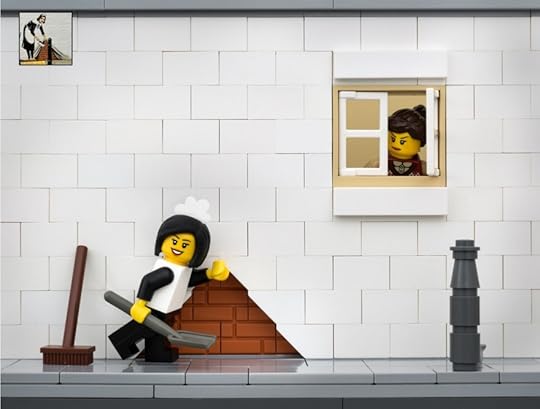Kill Screen Magazine's Blog, page 193
November 18, 2015
Anamorphine and the rise of the first-person narrative game
Georges Méliès discovered filmmaking’s jump cut by accident. By cutting out some of the frames in a single, still camera shot and splicing the two separate parts, it seemed as if objects were teleporting through space when watched back in real-time. In his 1898 short The Temptation of St. Anthony, he uses the jump cut to have women magically appear around the titular character, attempting to seduce him from his faith, before disappearing just as suddenly.
Méliès used the jump cut to become the great cinematic illusionist he’s now known as, producing what appeared to be magic through editing alone, and long before any concept of film-specific special effects existed—in fact, he invented a lot of it. What’s special about the jump cut is that it is (or, at least, was) a technique specific to cinema and helped to widen its lexicon when telling stories.
videogames are going through a similar phase of invention.
Some hundred years later, it seems that videogames are going through a similar phase of invention. We’ve already seen some games adapting cinematic techniques such as jump cuts and split-screen to tell their stories. But now, with the rise of the first-person narrative game, comes a storytelling technique that seemingly couldn’t exist in film (although it’s already part of virtual reality filmmaking) or anything else that came before videogames.

As with the jump cut, this technique is illusory and messes with our sense of time and space to make a connection between two or more places, people, or events. You’ve probably seen it used before as part of a mind-bending puzzle in a game, but now it’s being used with pure narrative intent. It goes something like this: You walk into a room from a first-person perspective, you turnaround to face where you just came from, and when you turn back around again the room has changed in some significant way.
Vital to this technique is that the transition is seamless so that it goes unnoticed. It makes use of your limited vision in the first-person perspective to make sudden changes to the environment when you’re not looking at parts of it. I’ve seen it pop up more frequently over the past couple of years in different games (keep an eye on That Dragon, Cancer) but the one, for me, that seems to be making the best use of it so far is the upcoming surreal adventure Anamorphine.
bottles of alcohol play the part of transitional materials
The game first appeared to me as a video of a prototype back in January 2014. You can still watch that video here. It showcased an interesting use of perspective as a means to have the player unknowingly cause changes in their surroundings. The objects in rooms change positions as the player simply looks around and, right at the end of the video, you see a series of pillars that seem whole and complete from one angle, but are revealed to be fragmented when viewed from any other angle. Those illusions are fun to experience and certainly fit the surreal tones on display but don’t outwardly interact with any narrative.
Now, with the latest build and trailer, the team behind Anamorphine are able to show how they’re using these perspective illusions to create a narrative with “no language, cut scenes, UI or action button.” Unfortunately, discussing the narrative would be to spoil it, as it’s meant to be interpretative; experienced first-hand by the player for them to think about. That being said, what I think I can get away with saying is that central to Anamorphine‘s narrative is travelling through the memories of a troubled mind. And trust me when I say it makes sense that you don’t have much control of the transitions between these memories. By simply staring at objects or looking around a room, you move between places almost by accident; places and characters spilling into each other.
Everything from photos and bottles of alcohol play the part of transitional materials and they’re bundled up in allegorical significance (alcohol as an “escape”). Objects also crumble as those pillars did in the old prototype to represent heartbreaking fractures in the memories. What strikes me about Anamorphine as impressive is how the team has incorporated the act of looking and moving around inside a 3D space from a first-person perspective into its storytelling. And it’s all wrapped up in metaphorical imagery so that almost every second of the journey can be read into for meaning. It’s actually quite exciting, at least to me, to see this singular technique develop as videogame creators learn to make use of the medium’s strengths to craft original ways to communicate a narrative idea.
You can find out more about Anamorphine on its website.


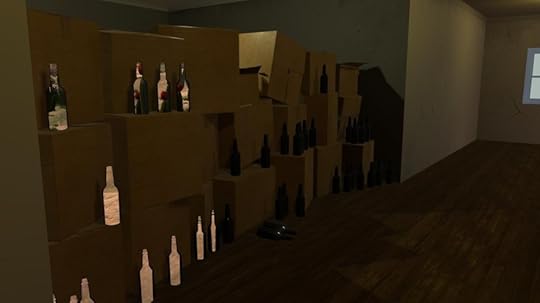
Why the creator of one of Steam’s most hated games made a sequel
“The sequel no one asked for,” begins one user review of Uriel’s Chasm 2: את on Steam. It’s a solid thumbs-down verdict and it sums up the general sentiment surrounding the sequel to one of Steam’s most hated games.
Uriel’s Chasm has around 2,500 user reviews and not even a fifth of them are positive (that is, giving the game a thumbs-up). This leaves it with a rare “Overwhelmingly Negative” verdict. In the Steam forums for Uriel’s Chasm 2 one person asks its creator, straight up, “what in the world would possess you to create a part 2?” It’s a good question.
“something darkly rebellious and destructively psychedelic”
Dylan Barry, the Welsh creator of Uriel’s Chasm, admits that he was never going to make anything ‘normal’. He turned to micro-game development after being a failed musician and busker (you can listen to his newer songs here). Indie Game: The Movie was the catalyst. Barry saw in that movie people describing the games they were making as a musician would the songs they had written—something intensely personal. It opened his eyes to the potential of making his own videogames.
“I had no idea people were writing games like songs these days,” Barry told me. “I’ve been writing songs since I was about 16 and to me this was like a whole new palette of emotion.”
What Barry saw in Indie Game: The Movie is likely different to what you or I did as he was coming to it without any prior knowledge of the subject. After his viewing, he saw the word “indie” as meaning “something darkly rebellious and destructively psychedelic,” and he fully planned to use that understanding of it as a launch pad. In truth, the movie wasn’t Barry’s first contact with the world of videogames. He had, in fact, happened across a few games on the Amstrad back in 1988, and instantly fell in love with how surreal they were. He points to the black skies the games back then often had due to the technical limitations, placing entire levels inside voids. One game he picks out is Spindizzy—the hard-edged 1986 action-puzzler—for its use of color to discern ice and desert levels, yet still hung them against that black sky.
These games captured Barry’s imagination but, more than that, he says they caused a religious awakening in him: “I remember the time I accidentally put a magnet up to my monitor and it was like the apes finding the obelisk in 2001: A Space Odyssey. I wept bitterly all night, not able to revert back to the blackness, first time I ever prayed to the God I would later follow.” If you haven’t tried it yourself (and you probably shouldn’t, by the way) putting a magnet up to an older computer monitor dramatically transforms it into a conductor of the psychedelic.
After that night, Barry tried to hack out artistic games on his Amstrad BASIC, but soon became frustrated at his lack of technical know-how. He remarks that with this frustration came a certain attitude that he hasn’t let go. When making games with the more accessible development tools of today, Barry channels his younger self, inspired by the lyrical worlds that he imagines when listening to the songs of Swans and Soundgarden. “Polish or popular conventions don’t usually come into it,” Barry says. “Originality was always my reason for everything, I will 100 percent go down with this ship.”
It’s this attitude that has led to the creation of Barry’s games. You can see in them quite clearly the hallmark of ’80s shmups, and his love of Codemasters quattro packs, as well as the mini-game laden film licensed titles of 30 years ago. But Barry mixes this with another big part of his life as a born-again Christian. Nearly all of his games feature religious themes, referring to parts of the bible in their stories, or challenging players to restore their faith. “I’m not really making Christian games but I love some of the interpretive techniques the Apostles used to unwrap the Old Testament,” Barry says. “Greek metaphysics and typology.” The result of all this is a baffling concoction of references to the Nephilim and outer-space demon monstrosities, all wrapped in up a shovelware aesthetic.
devilish rituals spun furiously into a tangled web of meta-fiction
Barry didn’t realize that bringing these games to Steam would seemingly offend so many people. He saw in their reaction a familiar “religious behaviour,” as if he had walked into their temple and smashed their stone commandments, which laid out what games were and how they should be. Small details such as not having an Options menu was enough for some to scream bloody murder. It was for aspects such as this, along with its esoteric narrative and peculiar challenges, that Uriel’s Chasm was labeled “bundleware” by its many new players after 2500 copies of it were given away for free as part of various promotions. But Barry wore this label as a badge of honor. This is exactly what he was going for. “My aim was to potentially change a person’s life with something made for mass bundling,” he tells me. “I wanted to play right into the pigeon hole I’d been put in, then feel around for the walls, the limitations of exactly what could be achieved in that dark place.”
This was an aim that had emerged in Barry since people had read much deeper into his first game (//N.P.P.D. RUSH//- The milk of Ultraviolet, which he describes simply as an “action game with organ trafficking”) than he could have expected. They traded passion poems and odd interpretative stories with each other after their time with the game. Seeing this, Barry decided to make games for these people, and these people alone. Fuck what anyone else thought. This is why he has since gone out of his way to create a loosely connected universe for his games to be united within. Settings from one game bleeds into another as grainy VHS footage, cults and their devilish rituals spun furiously into a tangled web of meta-fiction meant to encourage you to join the dots. Barry was particularly inspired by the Five Nights At Freddy’s series of horror games—which his eight-year-old son is infatuated with—and how its creator Scott Cawthon had found the fun of stringing its community along with deliberately obtuse lore.
Putting all of this together inside his games has been a journey of self-discovery for Barry. He’s piled on pounds and then lost it all by surviving on a diet of fruit. He left church due to theological issues and grew increasingly paranoid (most of this happening during the development of Selfie: Sisters of the Amniotic Lens). He’s pushed through these dark times and continued creating. And now, with Uriel’s Chasm 2 being his latest creation—stylized as a ROM hack and “multi-genre Love story”—he says it’s the “deepest” of his yet. “It’s heavily encrypted with all kinds of things, relating to other games and also themes such as the garden of Eden, Cain and Abel’s sacrifices, Satan, the 16-year-old me on BASIC, and the fruit is actually subconsciously put in there because of the huge lifestyle changes I had to make,” Barry says.
It’s so personal as to be convoluted. But if just one person can find something in Uriel’s Chasm 2 that changes their life even slightly then Dylan Barry will be satisfied.
You can purchase Uriel’s Chasm 2: את on Steam.
This puzzle game doesn’t have a name yet, but its gifs speak for themselves
Like Lara Croft GO meets Monument Valley, this unnamed puzzle game seems to merge elements of impossible architecture with a bright, low-poly look inspired by board games.
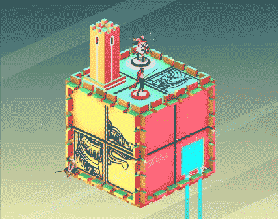
Levels are seemingly set on Rubik’s Cube-like environments, each cube adorned with mini castles, rocky cliffs, and flowing waterfalls that can be rotated to create a new path for the miniatures that are attempting to navigate the ever-changing surface.
Based on its most recent gif, some levels even come with narrative exposition in the form of floating text that moves with the direction of the cube it’s attached to, delivering more story with each revelatory rotation.
It’s hard to determine much else about this game based on what’s available, but it sure looks nice. For now, you can follow it on for updates.
Blackout uses glitches to bring a modicum of empathy to VR
The common conceit associated with virtual reality filmmaking is that the technology gives you a profound insight into the lives of others. More spatial depth, the theory goes, is correlated with more emotional depth. Welcome to the magical empathy machine!
This sort of technological determinism is almost always bunk, but that does not mean VR filmmaking cannot be used as a means to those ends. Blackout, a virtual reality documentary by the creative studio Specular, is the latest work that attempts to use VR as a tool for understanding others, yet it stands out because it seems at least partially aware of the technology’s limitations.
gain insight into the thinking of your fellow riders.
The central conceit of the documentary, which just started its Kickstarter campaign, is that you are a passenger on a train who, when the power goes out, can gain insight into the thinking of your fellow riders. This is like a high concept What Women Want—but, you know, good. There are thirty passengers in this train, each of whom hails from a different walk of life or background. You can navigate Blackout in whatever order you want, but the viewer should always come away with some broader understanding of others.
Achieving such insights into the lives of others, however, requires a good deal of artifice. Specular filmed its interviews with the various subjects of Blackout in a studio before being digitally inserted into the animated train carriage. In order to capture all three dimensions, Specular developed DepthKit, a tool that combines a DSLR camera and Microsoft’s Kinect to translate depth into physical space. It may be a touch presumptuous for Specular to call this technology the future of VR filmmaking, but the results in Blackout’s trailer are nevertheless promising. Characters do appear to have real depth, but the glitches in how these characters are depicted add a great deal of charm. The film easily avoids the uncanny valley.
The transparency of the artifice also helps Blackout avoid the disingenuous trap of most of VR filmmaking and, indeed, many documentary works. Neither technology nor the act of taking footage can guarantee that the viewer will really learn anything about a work’s subject. As Vinson Cunningham notes in an excellent New Yorker essay on the blog-cum-social-media-phenomenon-cum-book Humans of New York:
“The humans in Stanton’s photos—just like the most photogenic and happy-seeming and apparently knowable humans in your timeline—are well and softly lit, almost laminated; the city recedes behind them in a still-recognizable blur. We understand each entry as something snatched from right here, from someplace culturally adjacent, if not identical, to the watcher’s world; there’s a sense (and, given Stanton’s apparent tirelessness, a corresponding reality) that this could just as easily be you, today, beaming out from the open windowpane of someone else’s news feed. Any ambiguity or intrigue to be found in a HONY photo is chased out into the open, and, ultimately, annihilated by Stanton’s captions, and by the satisfaction that he seems to want his followers to feel.”
VR Filmmaking often accomplishes a similar trick to the one Cunningham decries. It places you right in the midst of event without stopping to think about what the proximity does to a viewer. Insofar as much of the VR filmmaking cannon is currently disaster porn, the Oculus Rift-owning (or even Google Cardboard-owning) viewer most likely can recognize that this is not their life. But the immediacy is still at odds with a greater sense of what the medium cannot reveal.
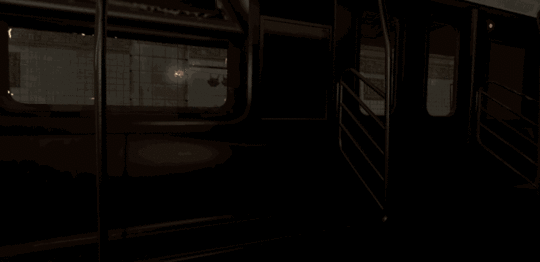
For formal and narrative reasons, VR filmmaking is bad at momentarily pulling back, which is what these works most often need. I cannot guarantee that Blackout will succeed in this regard, but its approach to filmmaking suggests that it might be more transparent in its intermediation. The people in Blackout are real, but the filmmaking can serve as a useful reminder that you will never know everything about them. That, it turns out, is actually the key to understanding others.
You can support Blackout over on Kickstarter.
Banksy gets Banksy-er with the addition of LEGO
Maybe photographer Jeff Friesen is Banksy. I don’t have any real reason to believe that this is the case, but all Banksy-adjacent content should include some unfounded speculation about the mysterious artist’s true identity, so that’s my duty dispensed with.
Here’s something I know for a fact about Friesen: He has put together a book entitled Bricksy: Unauthorized Underground Brick Street Art. The $15 tome features 84 Lego scenes, each of which is based on one of Banksy’s works. Friesen has some priors in this regard. The Canadian photographer’s last book, United States of LEGO®: A Brick Tour of America, recast classic American tropes and scenes using the famous Danish children’s toys. And really the leap from making an Americana diorama to a Banksy street isn’t that large; both are works of satire though the extent to which they are self-aware is definitely up for debate.
Maybe Bricksy is the perfect distillation of Banksy’s oeuvre.
At least Friesen seems to be in on the joke. Although LEGO is a flexible medium, it does tend to subsume all source material to its aesthetic. Consequently, Friesen’s dioramas, which already took a fair amount of creative license in reimagining Banksy’s work, all look like a mildly subversive LEGO village. One might ask whether this makes Banksy’s work edgier or more milquetoast: I leave that question to you, dear reader.
Maybe Bricksy is the perfect distillation of Banksy’s oeuvre. (Shit, did I just call it that?) Whereas the maximalist Dismaland sought to get at the themes and convoluted commercialism of Banksy’s work through little more than sprawl, Friesen’s tableaus suggest that the artist’s body of work is fundamentally compact. Little images of Banksy’s works dot the top corner of each page like a stamp. The size seems apt. If you reduced Banksy’s work any more, you’d just have a wad of cash.
(Bonus alternate theory: Bricksy is actually the work of Ai Weiwei, because LEGO only supports some forms of artistic expression. Suddenly the Friesen-as-Banksy theory seems borderline credible.)
November 17, 2015
Void and Meddler is lovely but lonely
It’s a gorgeous evening in Void & Meddler’s synth-wave nightscape. The downtempo music is pulsing, rain is falling, and I’m guiding my protagonist Fyn through a market of vibrant neofuturistic goods. I click on some fish, stacked near a bobbing robot merchant.
“No, just no,” Fyn tells me.
I click on the pile of fish again.
“No way.”
///
Booting up the game, I knew from a single glance that Fyn and I were not going to get along. With her hips perpetually half-crooked and a look of withering disinterest carved into her expression, Void & Meddler’s protagonist is all attitude. The plot seems moderately invested in proving that she has some substance, but by the end of Episode 1, I never saw it. Fyn isn’t simply an awful person: she is an unsympathetic and empty void, lacking in personality. Which is a damn shame for a game overflowing with atmosphere and ideas.
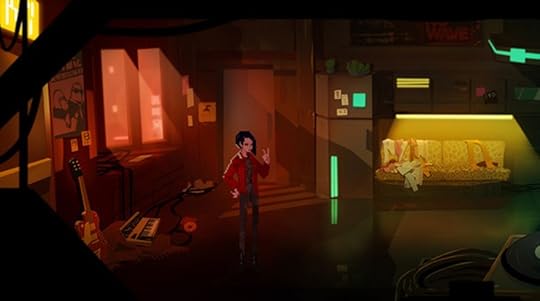
Like Mi-Clos Studios’ bitter space survivalism in Out There, Void & Meddler is evocative and colorful: every screen is awash in gorgeous shades that just “pop” and pretty shit to click on. There’s a pervasive feeling of alienation and loneliness here, a consistency of tone that arises from the moody color palette and music.
Starting out in Fyn’s apartment, I investigate the heap of pills on the bathroom floor, the breathing shape of some one-night-stand still in bed, then settle on a mass of tangled wires and a guitar in the corner of the room.
“I don’t have time for that,” she says.
As we leave her apartment, Fyn calls her bandmates assholes. Shoplifting from the convenience store is her “job perk.” When she opens up to her boss, he shoots himself in the head, then comes back to life. We chase down the one old man in the city who doesn’t have any implants so we can hold him up at knifepoint and pump him for information.
///
In a violet-magenta warehouse full of dancing young people—transhumans, shelled-out druggies, hormone junkies—I hover my mouse over the crowd and ask Fyn to describe someone.
There’s a pervasive feeling of alienation and loneliness
“I’m not going to describe everyone in this room,” she says.
And why should she? The world in which she lives is a neon bloodbuzz. It’s more interesting to look at how the light plays off the smoke and darkness than it is to describe the characters grinding on the dance floor. Like Blade Runner, the cyberpunk society of which Fyn is a product is all glitz and glam: I am seduced by bright lights, moody atmosphere, pulsing drama of synthetic beats. Talking to its inhabitants—or listening to Fyn grouse about the work she has to do to examine her environment—seems mind-numbingly boring in comparison.
I direct Fyn to pick up a magazine on the floor of the subway station.
“Nah I’m not a sports person,” she says dismissively.
///
In one sense, the writing in Void & Meddler is pitch-perfect. One out of ten interactions will read with the crisp distance of strangers passing in a nightclub, which in turn feeds the game’s glorious aura of alienation. The rest of the humor is dark but vacuous: in the chapter’s most memorable and fucked-up moment, Fyn corners an angsty teenager hooked up to a VR game called “Spit on Me” in a vintage arcade. She learns from a gaggle of nearby teens that his girlfriend recently dumped him and he’s having a hard time getting over her.
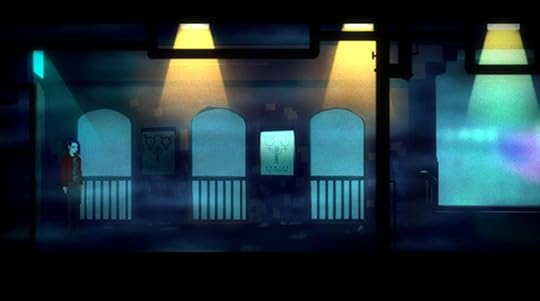
We need a distraction to keep going in the game, so Fyn eggs the boy on, tells him he’s ugly and doesn’t take care of himself. She tells him that’s why his girlfriend left him, and he’ll die alone, and that she’ll be comforting his girlfriend tonight. Sparks issue from the boy’s VR helmet, and he goes limp in his rig.
“You killed him,” one of his friends exclaims. But Fyn isn’t listening; the floor attendant is already busy cleaning up, and there’s more to do.
///
Void & Meddler is a headgame, like a lot of good cyberpunk. What is actually happening to Fyn? What is real and what is not real? Is her experience one long narrative of a night of suicidal ideation? So little is revealed in this first chapter that it’s difficult to say. And in its stubborn refusal to adhere to convention or basic narrative, Void & Meddler lags significantly. Throughout the episode, a number of key moments play out—promises made, favors cashed, teenagers fried—that might lead to some legitimate payoff in later episodes, but who can say at this point?
Void & Meddler is a headgame, like a lot of good cyberpunk.
And it’s here that Void & Meddler falls short: not for lack of promises, intrigue or atmosphere, but because its plotting is directionless, its protagonist entirely unlikeable. The game is aesthetically rich, but it lacks heart. Fyn is the epitome of a self-entitled city brat: catty, selfish, and unduly world-weary. And while chapters 2 and 3 might reveal more, it’s hard to muster any compassion for a story about a character as unrelateable as Fyn.
For more about Kill Screen’s ratings system and review policy, click here.
Void and Meddler Review
It’s a gorgeous evening in Void & Meddler’s synth-wave nightscape. The downtempo music is pulsing, rain is falling, and I’m guiding my protagonist Fyn through a market of vibrant neofuturistic goods. I click on some fish, stacked near a bobbing robot merchant.
“No, just no,” Fyn tells me.
I click on the pile of fish again.
“No way.”
///
Booting up the game, I knew from a single glance that Fyn and I were not going to get along. With her hips perpetually half-crooked and a look of withering disinterest carved into her expression, Void & Meddler’s protagonist is all attitude. The plot seems moderately invested in proving that she has some substance, but by the end of Episode 1, I never saw it. Fyn isn’t simply an awful person: she is an unsympathetic and empty void, lacking in personality. Which is a damn shame for a game overflowing with atmosphere and ideas.

Like Mi-Clos Studios’ bitter space survivalism in Out There, Void & Meddler is evocative and colorful: every screen is awash in gorgeous shades that just “pop” and pretty shit to click on. There’s a pervasive feeling of alienation and loneliness here, a consistency of tone that arises from the moody color palette and music.
Starting out in Fyn’s apartment, I investigate the heap of pills on the bathroom floor, the breathing shape of some one-night-stand still in bed, then settle on a mass of tangled wires and a guitar in the corner of the room.
“I don’t have time for that,” she says.
As we leave her apartment, Fyn calls her bandmates assholes. Shoplifting from the convenience store is her “job perk.” When she opens up to her boss, he shoots himself in the head, then comes back to life. We chase down the one old man in the city who doesn’t have any implants so we can hold him up at knifepoint and pump him for information.
///
In a violet-magenta warehouse full of dancing young people—transhumans, shelled-out druggies, hormone junkies—I hover my mouse over the crowd and ask Fyn to describe someone.
There’s a pervasive feeling of alienation and loneliness
“I’m not going to describe everyone in this room,” she says.
And why should she? The world in which she lives is a neon bloodbuzz. It’s more interesting to look at how the light plays off the smoke and darkness than it is to describe the characters grinding on the dance floor. Like Blade Runner, the cyberpunk society of which Fyn is a product is all glitz and glam: I am seduced by bright lights, moody atmosphere, pulsing drama of synthetic beats. Talking to its inhabitants—or listening to Fyn grouse about the work she has to do to examine her environment—seems mind-numbingly boring in comparison.
I direct Fyn to pick up a magazine on the floor of the subway station.
“Nah I’m not a sports person,” she says dismissively.
///
In one sense, the writing in Void & Meddler is pitch-perfect. One out of ten interactions will read with the crisp distance of strangers passing in a nightclub, which in turn feeds the game’s glorious aura of alienation. The rest of the humor is dark but vacuous: in the chapter’s most memorable and fucked-up moment, Fyn corners an angsty teenager hooked up to a VR game called “Spit on Me” in a vintage arcade. She learns from a gaggle of nearby teens that his girlfriend recently dumped him and he’s having a hard time getting over her.

We need a distraction to keep going in the game, so Fyn eggs the boy on, tells him he’s ugly and doesn’t take care of himself. She tells him that’s why his girlfriend left him, and he’ll die alone, and that she’ll be comforting his girlfriend tonight. Sparks issue from the boy’s VR helmet, and he goes limp in his rig.
“You killed him,” one of his friends exclaims. But Fyn isn’t listening; the floor attendant is already busy cleaning up, and there’s more to do.
///
Void & Meddler is a headgame, like a lot of good cyberpunk. What is actually happening to Fyn? What is real and what is not real? Is her experience one long narrative of a night of suicidal ideation? So little is revealed in this first chapter that it’s difficult to say. And in its stubborn refusal to adhere to convention or basic narrative, Void & Meddler lags significantly. Throughout the episode, a number of key moments play out—promises made, favors cashed, teenagers fried—that might lead to some legitimate payoff in later episodes, but who can say at this point?
Void & Meddler is a headgame, like a lot of good cyberpunk.
And it’s here that Void & Meddler falls short: not for lack of promises, intrigue or atmosphere, but because its plotting is directionless, its protagonist entirely unlikeable. The game is aesthetically rich, but it lacks heart. Fyn is the epitome of a self-entitled city brat: catty, selfish, and unduly world-weary. And while chapters 2 and 3 might reveal more, it’s hard to muster any compassion for a story about a character as unrelateable as Fyn.
For more about Kill Screen’s ratings system and review policy, click here.
Facebook filter adds the flags of all countries attacked by ISIS to your profile picture
The advent of Facebook solidarity profile filters and Twitter hashtags has irrevocably changed the way we experience far-off disasters. So much of this became clear following the devastating terrorist attacks on Paris this past Friday. Understandably moved by an overwhelming sense of helplessness and sympathy while watching the horrifying details unfold, much of the internet took to Facebook’s rallying cry to “change your profile picture to support France and the people of Paris.”
In the age of social media, the horror, panic, and chaos of a disaster gets filtered through the neat and searchable categories of each platform. Nowadays, no matter where you are in the world, you can feel like you participated in a calamity without ever even leaving the comfort of your own couch. Whether broadcasting a personal story or changing profile pictures, people appear to use social media as a means to try to make collective sense out of the unintelligible—to combat an act devoid of humanity by laying down our own virtual souls. Before promptly moving on.
to try to make collective sense out of the unintelligible
Within only half a day’s time after the initial reports—while the body count remained inconclusive and panic continued to reign over Paris—the social media blitz appeared to suddenly move past the “grief frenzy” stage of posting #prayforparis #tbt Eiffle Tower pics, and instead moved onto the outrage stage. Whoever didn’t adorn their profile with a French flag began, without any apparent prompting or criticism, to feel the need to defend their decision.
One French Facebook user whose anti-filter explanation went viral reads: “If I did this for only Paris this would be wrong. If I did this for every attack on the world, I would have to change my profile everyday several times a day.” In the wake of the equally horrifying attacks on Lebanon by ISIS suicide bombers just the day before France’s attack, many criticized Facebook for ignoring the suffering of other non-Western countries. In fact one site called LunaPics even went so far as to create its own Lebanon filter.
Mass media followed suit along with the online public outcry: whether it was Popsugar‘s somber opinions on “The Problem With Facebook’s France Filter” or the Independent‘s more accusatory “Got a French flag on your Facebook profile picture? Congratulations on your corporate white supremacy.” All shared the same basic line of inquiry: how do you quantify when a tragedy is big or important enough to warrant a Facebook filter?

A somewhat satirical website called Allflags.world took a different approach. Created by Moises (Art404), Slava (4Real), and Tom Galle, it presents the perfect solution: instead of choosing this or that suffering country to exhibit on your profile, why not show your ultra sensitivity by including the flag of every single nation attacked by ISIS. The running list so far includes: Syria, Iraq, Turkey, Lebanon, Pakistan, Israel, Serbia, Yemen, Nigeria, Sudan, Somalia, Cameroon, Bahrain, Russia, France, Egypt, Algeria, Afghanistan, Libya, Chad, Kenya, Brazil, Congo DRC, México, Tunisia, Palestine, and Bangladesh.
As is to be expected, the blending together of so many different national’ colors results in a filter that doesn’t communicate quite as clearly as the prototypical #prayforparis post. To an extent, the filter makes every user look like they’re in one of those creepy trans-dimensional Google Dream snapshots. The all-inclusive watermark filter, with its excess in color and noise, essentially takes over the profile picture altogether, rendering the discernible features of the user’s face indistinguishable.
Layered atop dozens of flags, the viewer loses site of the human being behind the profile picture. Instead, you see an entangled global web. While Facebook’s France filter captures individual grief experienced on a global scale, the Allflags filter returns the focus to the global circumstances that lead to the terrorist attacks. Granted, no matter how many countries it includes, Allflags is still just a Facebook filter that speaks more to our inherent need for comfort than our inherent desire to show solidarity. But, at the very least, it’s a filter that doesn’t shy away from the messy, cross-cultural clusterfuck that is the war on terrorism.
You can use Allflags.world for yourself here.
Lovely Weather We’re Having is as pleasant as its name implies
I forgot my keys in grade nine. Without a local haunt to hang out in or a nearby relative, without cellphones catching on as commonplace to see who else was around, I sat by a large tree that grew right on the property line at the end of the front yard. I sat there and read some math exercises, until a light rain began and decided that I should spare the sheets of paper a dampness I couldn’t spare myself from. A woman I didn’t recognize passed by and glanced over as I slumped with my coat and bags. She asked if I was alright, I told her I was just locked out. “Damn girl,” she said, “you must be cold!” At this point in time I had a long paintbrush of hair that I thought was an attractive way to be a defiant teenager. In her defense, new neighbors often mistook me for a young woman as well.
a simulation of being locked out of the house
It rained a few days ago, early in the morning, a light drizzle just like that day. I sprang out of bed and opened Steam, because, unlike the time when I was locked out of the house in the real world, I was hoping for a rainy day so I could get locked out in the virtual. Julian Glander’s Lovely Weather We’re Having (Glander made that fun interactive Celestial Shores video) is a small digital village that synchronizes with the local weather—it’s a simulation of being locked out of the house, and accurate to the real deal, presents you with the confrontation of small talk.
Toronto has been uncharacteristically lovely for most of November, which somehow became a pain in my ass in reviewing a videogame. Every visit to Glander’s world was nearly identical. A cool teen hangs out against the wall. A caterpillar hovers around its tiny town. A computer person asks you to guess a number. The party pig keeps it real in the pond. One villager, a multicoloured bee hive with googly eyes, wishes it was just a few degrees warmer, but it is fall now, hive dude, and it can’t be summer forever.
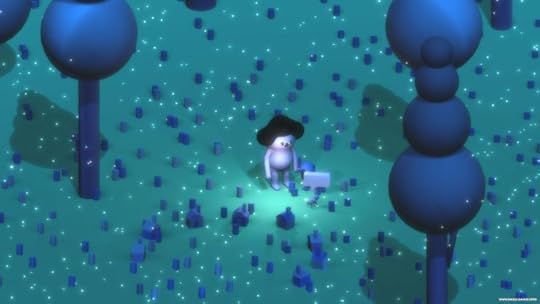
Some villagers seem to pop in and out depending on the time of day, and some conversation trees do seem to change in the sunshine or the rain. A talking rock who is generally a curmudgeon finally opened up to me to air about its life anxieties during the downpour. There is talk of a monster in the mountains, a conspiracy supported by a lone door sticking out of the rockface. At night no one is around, other than you and your little puppy, because I suppose you still haven’t found those keys. Everyone else is sound asleep.
Glander’s world is pretty. Everything is made of marshmallows. The colors of the soil look like mirrors to the hue of a sun you never see. You can have a conversation with a bundle of grapes about the strange glow of the tall grass, regarding if it is magic or weird science. The roaming cast are a combination between Patrick Kyle’s shapes and Aardman’s Rex the Runt. Walking through or over some parts of nature make synthetic drum blips akin to the musical geography of Proteus, though that symphony seems less of a priority to Lovely Weather and more of a function of the strange toy it happens to be. This game is an action-figure playset for the zine scene. We don’t have a He-Man doll fighting the Joker, we have wads of clay shaped like Ray Smuckles asking Hopey Glass if this hat makes him look like a clown.
Lovely Weather is Animal Crossing without all the stuff
The weather, the concept that is the game’s biggest ambitions, is interesting, but instead of making me connect the virtual snowglobe to the atmosphere outside my window I only end up contrasting. It was sunny and warm throughout the week, which the game knew, but it was also windy with leaves strewn everywhere, while the game was devoid of litter. When the snowy seasons begin, I will check back in to see if the magical white specks stir up hopeful sentimentalities in me, and it probably will (I am a big sucker when it comes to Banjo-Kazooie’s Freezeezy Peak), but it won’t remind me of the grey slush mountains that plague my hometown throughout the season. Lovely Weather We’re Having is the idyllic cartoon version of whatever is happening outside, the variation where you can always hang out amidst it. Only details are ugly.
Gavin Volure, played by Steve Martin on 30 Rock, once called Toronto “New York without all the stuff.” Lovely Weather is Animal Crossing without all the stuff. There’s no consequences for your actions or chores to complete. You can kick all of the caterpillar’s tiny homes into the ocean and topple all of the trees and the world will reset, you still locked out, the next time you play. Change comes to the game when change comes to your clouds and sun and moon, when you hover around the tiny village making small talk, at times about the weather, but mostly quirky facetious comix-speak. And, like a sun shower, that’s nice—if small.
For more about Kill Screen’s ratings system and review policy, click here.
Philip K. Dick is getting his very own videogame tribute
Californium doesn’t have the look of a videogame about Philip K. Dick. We’re used to the somber, rainy cityscapes of Blade Runner when we think of the sci-fi author. Yet it may be the truest adaptation of the man and his work yet—the vibrant wash of summery hues included.
It’s to be a first-person exploration game made as tribute to Philip K. Dick. “You just have to walk around, talk to people, look around, and search for things that are not normal,” explained producer Noam Roubah to Ars Technica. So far so typical for the genre, then. But Californium will also delve into reality shifts. “At some point, maybe, you might see glasses on the table only to have it change into a book,2 continued Roubah. “When you find abnormal things like that, you will expose another reality.”
The idea behind Californium originally sprung up four years ago as the 30th anniversary of Dick’s death in 2012 approached. It has since become a transmedia project that’s paired with a documentary called “The Worlds of Philip K. Dick.” Both projects look to explore how Dick’s vision in his own life and his fictions are reflected in contemporary society.
Californium takes mostly from Dick’s 1981 novel VALIS. While that novel is a work of fiction it can almost be read as semi-autobiographical. The narrator, Horselover Fat (a stand-in for Dick himself), believes that there are multiple realities, and that it’s possible to pick up on signals beamed around the planet—realized as visions—that reveal this hidden truth.
Dick kept a record of the phantasmagoric visions that he experienced from 1974 onwards. They are collated in The Exegesis of Philip K. Dick, which also explores how these visions, as well Dick’s thoughts on philosophy, religion, and science informed his fictions. The author also touches on his experiences with schizophrenia and recreational drug use in these journals, supposing this as a rational explanation for these visions, which is a possibility also reflected in VALIS.
“this world is unstable, you can extract yourself from it”
The themes of Californium run parallel with all of this; you play as a writer trapped between realities. More specifically, it’s set in 1967, your name is Elvin Green, and your life is crashing around you. Your wife leaves you and your editor drops you due to lack of writing (a major flaw for a writer, huh?). After taking acid, drinking lots of booze, and avoiding sleep while trying to type up a novel, Green starts getting visions.
“Your brain perceives a signal, the Theta – which seems connected to your collapsing emotional state – shows that there could be a way out : this world is unstable, you can extract yourself from it and thus access another reality! You have nothing to lose!” so goes the game’s description.
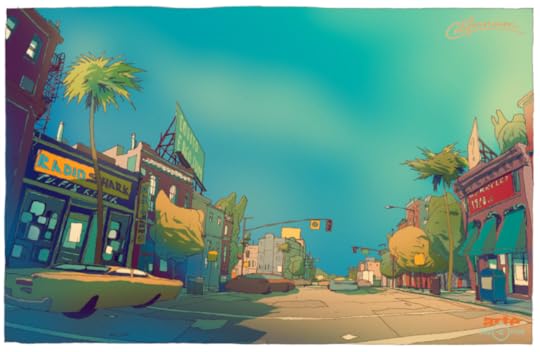
Bringing the world to life that you’ll explore in Californium is French illustrator Olivier Bonhomme. Have a look at Bonhomme’s website and you can see the connection between his illustrations and the surreal, bizarre mindfuck of Californium. Bonhomme was chosen for the project as the producers wanted to depart from the usual dreary artwork that Dick’s words are afforded and bring to life parts of him that usually escape adaptation—the occasional silliness and history of chemical experimentation.
“When you read Philip K. Dick, you realise the dystopia is not in the aesthetic, but its portrayal of human beings. His books were very fun and we wanted to keep this aesthetic,” Roubah said to Ars Technica.
The producer also mentioned that he and the team were toying with the idea of bringing a short experience based on Californium to virtual reality. It seems appropriate for a videogame all about the interstices of dimensional reality. I’m sure Dick himself would approve.
h/t Ars Technica
Kill Screen Magazine's Blog
- Kill Screen Magazine's profile
- 4 followers



